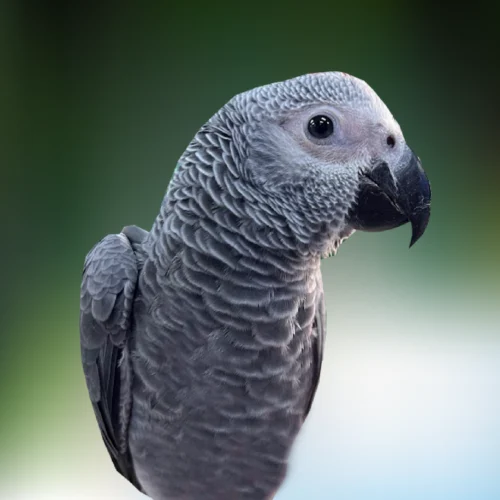

Congo African Grey Price, Lifespan, Care & Complete Companion Guide
Congo African Grey is known for its extraordinary intelligence and ability to form deep emotional connections, making it a lifelong companion with complex reasoning and problem-solving skills. Its capacity for mimicry reproducing human speech and sounds with stunning clarity makes it an unparalleled choice for bird enthusiasts who seek a companion capable of engaging in meaningful communication.
Buy Our Charming Congo African Grey at Dallas Parrots
Our Congo African Grey is the perfect choice, known for exceptional intelligence and emotional bonding. At Dallas Parrots, we offer healthy, hand-raised Congo African Greys that will bring joy and companionship for years to come. Visit us today and find your new feathered friend!
Recognizing a Congo African Grey
This parrot’s appearance is both elegant and iconic:
- Feathers: Sleek silver-grey plumage with a striking cherry-red tail
- Beak & Eyes: Jet-black beak and alert, pale-yellow eyes
- Size: Grows as long as 14 inches, with a wingspan reaching up to 20 inches.
- Comparison with Timneh: Timneh is smaller, darker, with a maroon tail and light-tipped beak
Lifespan & Commitment
Owing a Congo African Grey is a lifelong commitment, as these birds can live 40 to 60 years with proper care, becoming companions for decades. Their longevity is a testament to the bond they form with their caregivers, and this extended period is something that must be carefully considered before bringing one into your home.
In the wild, however, their lifespan is generally shorter due to environmental stressors, predators, and the dangers of their natural habitat. In contrast, a Congo African Grey in captivity will rely on you to meet all its needs — from emotional support to regular health checks — ensuring that its life is not only long but also fulfilling. If you choose to welcome one into your life, be prepared for a relationship that could stretch far beyond typical pet ownership, potentially outlasting the duration of other pet commitments or even your own lifetime.
Voice and Brainpower
The Congo African Grey is renowned for its ability to mimic human speech and understand meanings, responding thoughtfully to interactions. The mental stimulation it requires is key to preventing behavioral issues, ensuring it stays both sharp and content.
Vocabulary
A Congo African Grey can often learn and use over 100 words, incorporating them into conversations and using them appropriately in context.
Comprehension
Beyond mimicry, these birds can answer questions, name objects, and express their needs, showcasing a depth of understanding that is rare in the avian world.
Mental Stimulation
To maintain its intelligence, the Congo African Grey requires plenty of games, puzzles, and diverse activities to stay engaged and mentally fit.
What to Feed Your African Grey

Feeding your Congo African Grey a well-balanced diet of high-quality pellets and fresh fruits ensures their health, vitality, and long life. In addition to pellets, adding fresh fruits and vegetables not only brings variety to their diet but also strengthens their immune system. Treats, while enjoyable, should be given sparingly to prevent overfeeding and ensure proper weight management.
Staple Diet
Their diet should primarily consist of high-quality formulated pellets, making up about 60–70% of their total food intake. This ensures they receive the essential vitamins and minerals their body needs.
Fresh Fruits and Vegetables
Papaya, spinach, and carrots are great additions to their diet, offering a wide range of nutrients, antioxidants, and fiber to keep them healthy.
Moderate Treats
Treats such as nuts and seeds are great but should be offered in moderation to prevent excessive fat intake.
Foods to Avoid
Never offer avocado, chocolate, caffeine, or alcohol as they are toxic to parrots and can lead to serious health issues.
Consult with an Avian Vet
Working with an avian vet ensures that you can adjust their diet based on their health needs, weight management, and age. Regular consultations help keep your bird healthy in the long term.
Crafting the Right Living Space
A safe, engaging space makes a huge difference in your Grey’s well-being.
| Aspect | Details |
| Cage Dimensions | Minimum 36x24x48 inches for adequate space. |
| Perches | A mix of widths and materials to promote foot health. |
| Toys | Rotate regularly to avoid boredom and encourage mental stimulation. |
| Lighting | Natural light or UV-spectrum lighting supports mood and health. |
| Freedom | Daily out-of-cage time is essential for physical and social health. |
Bonding with Your Grey
Building a strong bond with your sensitive Congo African Grey is essential, as they form deep emotional connections with their caregivers. To ensure a fulfilling relationship, regular and meaningful interactions are crucial. This bond goes beyond feeding and cleaning; it requires genuine engagement and time spent together.
Daily Interaction
Consistent daily interaction is vital for your Grey’s emotional stability. They thrive on attention, affection, and companionship, so it’s essential to make time for activities like talking, playing, and even training. This interaction not only strengthens your bond but also prevents the bird from feeling neglected or lonely.
Mood Awareness
Congo African Greys are extremely perceptive of their owner’s emotions. They can sense changes in your mood and may mirror your feelings, showing empathy when you’re upset or sharing your excitement during happy moments. This emotional sensitivity makes the bond more profound, and it’s important to be mindful of your energy when interacting with them.
Trust Building
Establishing trust with your Congo Grey can take time, but once it’s achieved, it’s unshakeable. Building trust requires patience, positive reinforcement, and a calm, gentle approach. As they begin to trust you, they will open up, becoming more playful and affectionate. This deep bond is one of the defining characteristics of owning a Congo Grey.
Consequences of Neglect
Neglecting the emotional needs of a Congo Grey can lead to significant behavioral problems. Without enough interaction and care, they may experience anxiety or depression, leading to behaviors like excessive screaming or feather plucking. Consistent attention and emotional support are key to preventing these negative outcomes and maintaining a healthy relationship with your bird.
Training the Right Way
Training your Congo African Grey is about fostering strong communication and mental stimulation, as these intelligent parrots thrive on activities that challenge their brains.
The way you approach training plays a crucial role in not only teaching them but also strengthening the bond you share with them. Positive and patient training methods will help nurture a long-lasting relationship built on trust and mutual understanding.
Use Positive Reinforcement
One of the most effective methods for training your Congo Grey is positive reinforcement. Rewarding your parrot with food treats, gentle praise, or even extra playtime encourages them to repeat the behavior you want.
The key is consistency and making sure the reward follows immediately after the desired behavior. This creates a clear connection in your bird’s mind between their action and the reward, leading to faster and more successful training.
Be Consistent
Consistency is crucial when training a Congo Grey. Short, regular training sessions are far more effective than long, sporadic ones. Greys have short attention spans, so keeping sessions to 10-15 minutes, several times a day, helps keep them focused and engaged.
It’s also important to maintain consistency in your cues and rewards. This predictability helps your bird learn faster and reduces confusion, making training smoother for both of you.
Avoid Force
Unlike other animals, Congo African Greys are highly sensitive and will shut down or become fearful if subjected to forceful methods. Training through pressure or punishment can damage the trust you’ve built with your bird.
Instead, use calm, gentle techniques, always rewarding good behavior rather than punishing undesirable actions. Forceful training can lead to anxiety, stress, or even aggressive behavior, so it’s vital to be patient and understanding throughout the process.
Training as Brainwork and Bonding
Training isn’t just about teaching your Grey tricks or commands—it’s an excellent form of mental stimulation and an opportunity to bond with them. These sessions engage their intellect, which is vital for their well-being, helping to prevent boredom and destructive behaviors.
As you train, you’ll build a deeper connection, reinforcing the idea that you are a source of guidance and comfort. Training your Congo African Grey turns into a mutual experience that deepens your emotional connection and enriches your overall relationship.
Behavioral Challenges in Congo African Greys
Behavioral issues like feather plucking and aggression often arise from stress, boredom, poor socialization, or hormonal changes.
Vocal Outbursts: Can be a cry for attention or a sign of discomfort (like boredom or loneliness).
Underlying Causes: Behavioral issues are often linked to emotional distress, anxiety, or unmet needs.
Effective Solutions: Environmental enrichment, mental stimulation, and consistent routines can correct these behaviors.
Key Strategies for Correcting Behavioral Issues
- Provide Mental Stimulation: Use toys, puzzles, and training sessions to keep your Grey mentally engaged.
- Positive Reinforcement: Reward good behavior with treats and praise to reinforce positive actions.
- Establish Consistent Routines: Create a regular schedule for feeding, interaction, and rest.
- Patience and Understanding: Recognize that these behaviors are often signals of unmet emotional or physical needs and not deliberate misbehavior.
- Seek Professional Help: Consult an avian vet or bird behaviorist if issues persist or worsen.
Health Maintenance & Veterinary Care
Keeping your Congo African Grey healthy isn’t just about treating illness—it’s about creating a consistent care routine that focuses on prevention, early detection, and overall wellness. Because these birds are masters at hiding symptoms, regular check-ups and daily observations are crucial.
A vigilant owner who knows what to look for can often prevent minor concerns from turning into major health problems.
Key Aspects of Health Maintenance
| Health Component | Why It Matters |
| Annual Vet Visits | Helps detect early signs of disease or deficiencies before symptoms become serious. |
| Red Flag Symptoms | Watch for lethargy, changes in droppings, loss of appetite, or weight loss. |
| Grooming Checks | Regularly examine and maintain nails, beak, and feather condition. |
| Activity & Vocalization | A healthy Grey is usually active, curious, and vocal—sudden silence may signal a problem. |
| Clean Environment | Clean cages and perches regularly to reduce the risk of infections and parasites. |
| Hydration & Nutrition | Fresh water and a balanced diet are critical for maintaining immune strength. |
Thinking of Breeding? Know This First
Breeding a Congo African Grey is far more complex than simply housing a male and female together. It demands expertise, dedication, and a controlled environment that meets both physical and emotional needs. These parrots are not casual breeders—they form deep pair bonds and are highly sensitive to changes in their surroundings.
Without proper knowledge, attempting to breed them can result in severe stress, injury, or even death for the birds. It’s a responsibility that should only be taken on with serious preparation and professional guidance.
Why Breeding Requires Caution
Only for Experienced Keepers: Breeding Congo Greys is not suitable for first-time bird owners. It involves understanding avian behavior, nutrition, nesting needs, and chick care—all of which require extensive experience.
Controlled and Quiet Environment: These birds need a low-stress, quiet setting to feel secure enough to breed. A nesting box in a secluded area is essential, and even minor disturbances can cause the pair to abandon their nest.
Genuine Pair Compatibility: Not all male and female Greys will bond. True pair bonding is critical, and forced pairing often leads to fighting, aggression, or breeding failure.
Ethical Breeding Practices Matter: Poor handling, inadequate space, or lack of knowledge can lead to egg-binding, aggression, or poor chick health.
Legal and Ethical Considerations
The Congo African Grey is highly prized, which sadly makes it a target for illegal trafficking. It’s a species protected under international law, meaning trade is heavily regulated to prevent exploitation.
Wild-caught birds often face trauma, poor health, and difficulty adapting to domestic life. Ethically sourced parrots not only live healthier lives but also help in preserving the species in their native habitats. Your decision can directly influence conservation efforts.
The Real Cost of Ownership
Bringing home a Congo African Grey isn’t just a one-time purchase—it’s a long-term financial and emotional commitment. From the initial cost of acquiring the bird to setting up a proper cage and ongoing yearly maintenance, the investment adds up quickly.
High-quality food, toys, vet care, and enrichment tools are non-negotiable if you want your parrot to thrive. This bird isn’t for casual keepers—it’s for those prepared to invest in its well-being for decades.
Short and clear lines to accompany each section of the table:
| Category | Estimated Cost |
| Purchase Price | $1,000–$3,500 |
| Cage & Setup | $500–$1,000 |
| Annual Maintenance | $500–$1,000 |
Smart Ways to Keep Them Engaged
Mental stimulation is crucial for a Congo African Grey’s well-being, as without constant challenges, they can become bored, stressed, or develop undesirable behaviors. Engaging them in a variety of activities not only enhances their cognitive abilities but also nurtures their emotional and physical health.
Congo Grey vs Timneh Grey: What’s the Difference?
While both the Congo African Grey and Timneh African Grey belong to the same species group, they differ in key ways that affect ownership. From size and speech clarity to temperament and cost, each has unique traits that may suit different lifestyles. Understanding these differences helps future owners choose the companion that best fits their home and expectations.
| Trait | Congo African Grey | Timneh African Grey |
| Size | Larger (12–14 inches) | Smaller (10–11 inches) |
| Tail Color | Bright red | Maroon |
| Body Color | Light grey | Darker charcoal |
| Beak | Fully black | Light upper beak |
| Speech | Clearer articulation | Slightly softer tone |
| Personality | Shy, sensitive | Bolder, more adaptable |
| Cost | Higher | Slightly cheaper |
Conclusion
Welcoming a Congo African Grey into your life means embarking on a journey of companionship, learning, and deep connection. These intelligent, emotionally perceptive birds require more than just basic care; they need consistent interaction, trust-building, and a meaningful relationship. Their long lifespan, combined with their need for mental stimulation and affection, makes them a lifelong commitment. If you’re ready for a bird that will bond with you deeply and offer years of companionship, the Congo African Grey could be the perfect addition to your home.
FAQ's
How intelligent is the Congo African Grey parrot?
The Congo African Grey is considered one of the most intelligent bird species, capable of learning over 100 words and understanding their meanings. They also exhibit problem-solving skills and emotional awareness, making them exceptional communicators and lifelong companions.
What is the lifespan of a Congo African Grey?
With proper care, a Congo African Grey can live between 40 to 60 years in captivity. Their long lifespan makes them a significant, long-term commitment, often outliving other pets and sometimes their owners.
How do I bond with my Congo African Grey?
Daily interaction, positive reinforcement, and a calm, consistent routine help build trust. These birds are emotionally sensitive and require genuine engagement to form deep, lasting connections.
What should I feed my Congo African Grey?
A balanced diet includes 60–70% high-quality pellets, fresh fruits (like papaya), vegetables (like spinach and carrots), and occasional treats like nuts. Avoid avocado, chocolate, caffeine, and alcohol, as they are toxic.
Are Congo African Greys easy to train?
Yes, when trained with patience and positive reinforcement. They respond well to consistency and short training sessions (10–15 minutes). Forceful methods should be avoided as they can damage trust and lead to behavioral issues.
What are common behavioral challenges, and how can I prevent them?
Feather plucking, aggression, and vocal outbursts often result from stress, boredom, or neglect. Prevention includes mental stimulation, routine, attention, and, if needed, guidance from an avian behaviorist.



